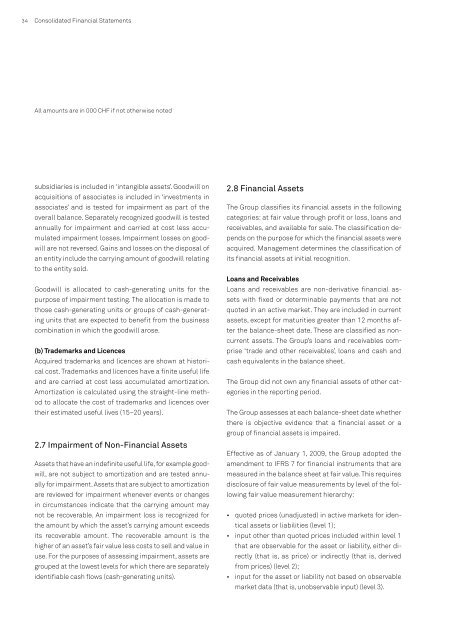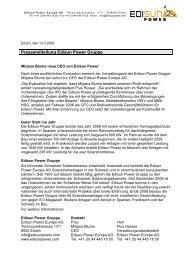Edisun Power Europe Ltd. Corporate Governance Report 2010 ...
Edisun Power Europe Ltd. Corporate Governance Report 2010 ...
Edisun Power Europe Ltd. Corporate Governance Report 2010 ...
Create successful ePaper yourself
Turn your PDF publications into a flip-book with our unique Google optimized e-Paper software.
34 Consolidated Financial Statements<br />
All amounts are in 000 CHF if not otherwise noted<br />
subsidiaries is included in ‘intangible assets’. Goodwill on<br />
acquisitions of associates is included in ‘investments in<br />
associates’ and is tested for impairment as part of the<br />
overall balance. Separately recognized goodwill is tested<br />
annually for impairment and carried at cost less accumulated<br />
impairment losses. Impairment losses on goodwill<br />
are not reversed. Gains and losses on the disposal of<br />
an entity include the carrying amount of goodwill relating<br />
to the entity sold.<br />
Goodwill is allocated to cash-generating units for the<br />
purpose of impairment testing. The allocation is made to<br />
those cash-generating units or groups of cash-generating<br />
units that are expected to benefit from the business<br />
combination in which the goodwill arose.<br />
(b) Trademarks and Licences<br />
Acquired trademarks and licences are shown at historical<br />
cost. Trademarks and licences have a finite useful life<br />
and are carried at cost less accumulated amortization.<br />
Amortization is calculated using the straight-line method<br />
to allocate the cost of trademarks and licences over<br />
their estimated useful lives (15–20 years).<br />
2.7 Impairment of Non-Financial Assets<br />
Assets that have an indefinite useful life, for example goodwill,<br />
are not subject to amortization and are tested annually<br />
for impairment. Assets that are subject to amortization<br />
are reviewed for impairment whenever events or changes<br />
in circumstances indicate that the carrying amount may<br />
not be recoverable. An impairment loss is recognized for<br />
the amount by which the asset’s carrying amount exceeds<br />
its recoverable amount. The recoverable amount is the<br />
higher of an asset’s fair value less costs to sell and value in<br />
use. For the purposes of assessing impairment, assets are<br />
grouped at the lowest levels for which there are separately<br />
identifiable cash flows (cash-generating units).<br />
2.8 Financial Assets<br />
The Group classifies its financial assets in the following<br />
categories: at fair value through profit or loss, loans and<br />
receivables, and available for sale. The classification depends<br />
on the purpose for which the financial assets were<br />
acquired. Management determines the classification of<br />
its financial assets at initial recognition.<br />
Loans and Receivables<br />
Loans and receivables are non-derivative financial assets<br />
with fixed or determinable payments that are not<br />
quoted in an active market. They are included in current<br />
assets, except for maturities greater than 12 months after<br />
the balance-sheet date. These are classified as noncurrent<br />
assets. The Group’s loans and receivables comprise<br />
‘trade and other receivables’, loans and cash and<br />
cash equivalents in the balance sheet.<br />
The Group did not own any financial assets of other categories<br />
in the reporting period.<br />
The Group assesses at each balance-sheet date whether<br />
there is objective evidence that a financial asset or a<br />
group of financial assets is impaired.<br />
Effective as of January 1, 2009, the Group adopted the<br />
amendment to IFRS 7 for financial instruments that are<br />
measured in the balance sheet at fair value. This requires<br />
disclosure of fair value measurements by level of the following<br />
fair value measurement hierarchy:<br />
• quoted prices (unadjusted) in active markets for identical<br />
assets or liabilities (level 1);<br />
• input other than quoted prices included within level 1<br />
that are observable for the asset or liability, either directly<br />
(that is, as price) or indirectly (that is, derived<br />
from prices) (level 2);<br />
• input for the asset or liability not based on observable<br />
market data (that is, unobservable input) (level 3).



